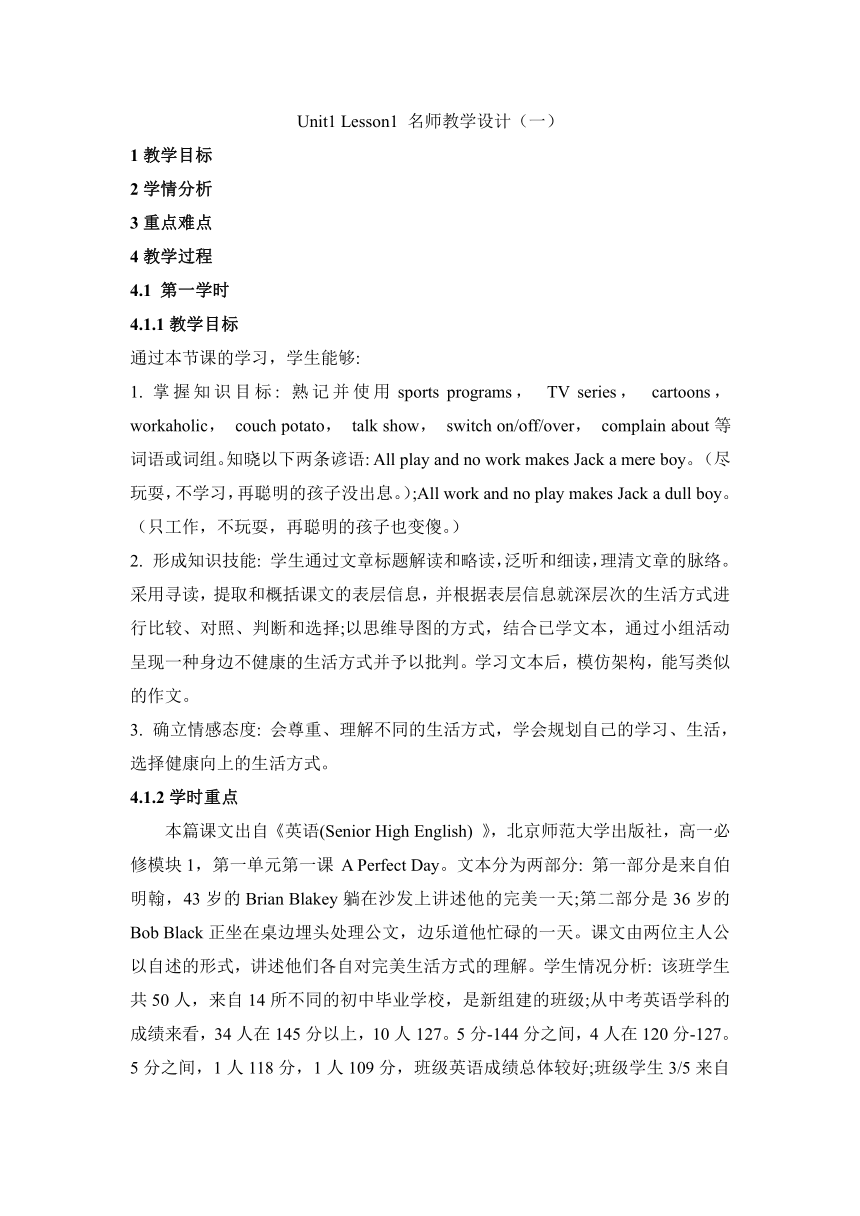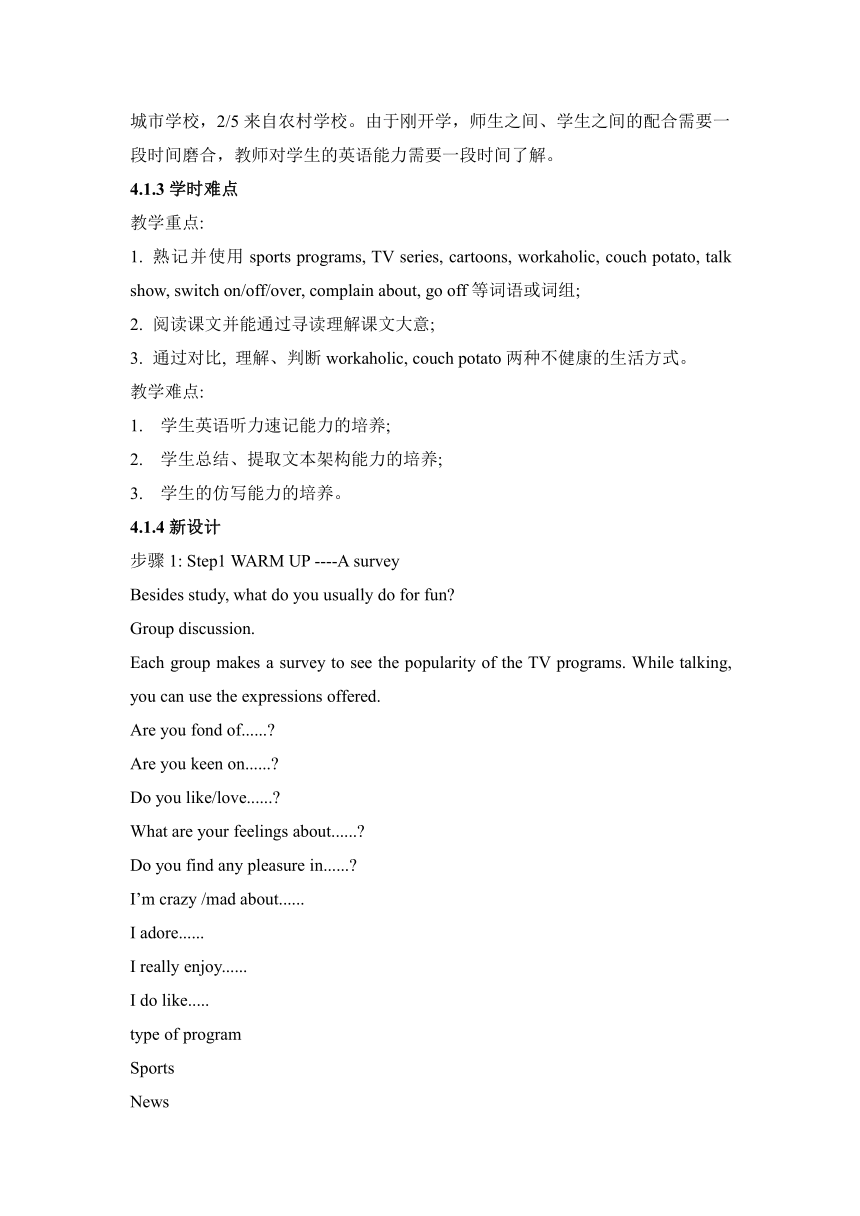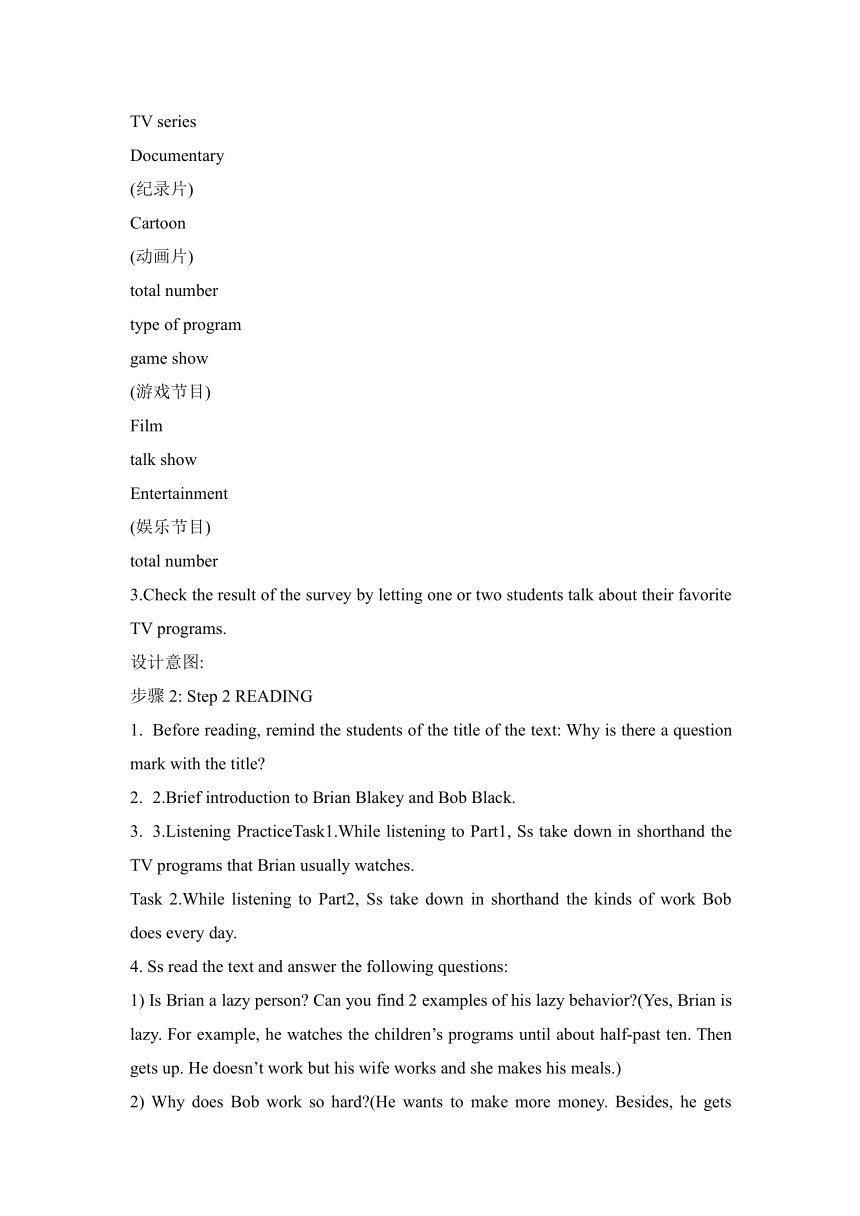北师大版(2019)必修 第一册Unit 1 Life Choices Lesson 1 Lifestyles名师教学设计一
文档属性
| 名称 | 北师大版(2019)必修 第一册Unit 1 Life Choices Lesson 1 Lifestyles名师教学设计一 |  | |
| 格式 | doc | ||
| 文件大小 | 30.0KB | ||
| 资源类型 | 教案 | ||
| 版本资源 | 北师大版(2019) | ||
| 科目 | 英语 | ||
| 更新时间 | 2023-03-13 22:49:34 | ||
图片预览



文档简介
Unit1 Lesson1 名师教学设计(一)
1教学目标
2学情分析
3重点难点
4教学过程
4.1 第一学时
4.1.1教学目标
通过本节课的学习,学生能够:
掌握知识目标: 熟记并使用sports programs, TV series, cartoons, workaholic, couch potato, talk show, switch on/off/over, complain about等词语或词组。知晓以下两条谚语: All play and no work makes Jack a mere boy。 (尽玩耍,不学习,再聪明的孩子没出息。);All work and no play makes Jack a dull boy。 (只工作,不玩耍,再聪明的孩子也变傻。)
形成知识技能: 学生通过文章标题解读和略读,泛听和细读,理清文章的脉络。采用寻读,提取和概括课文的表层信息,并根据表层信息就深层次的生活方式进行比较、对照、判断和选择;以思维导图的方式,结合已学文本,通过小组活动呈现一种身边不健康的生活方式并予以批判。学习文本后,模仿架构,能写类似的作文。
确立情感态度: 会尊重、理解不同的生活方式,学会规划自己的学习、生活,选择健康向上的生活方式。
4.1.2学时重点
本篇课文出自《英语(Senior High English) 》,北京师范大学出版社,高一必修模块1,第一单元第一课 A Perfect Day。文本分为两部分: 第一部分是来自伯明翰,43岁的Brian Blakey躺在沙发上讲述他的完美一天;第二部分是36岁的Bob Black正坐在桌边埋头处理公文,边乐道他忙碌的一天。课文由两位主人公以自述的形式,讲述他们各自对完美生活方式的理解。学生情况分析: 该班学生共50人,来自14所不同的初中毕业学校,是新组建的班级;从中考英语学科的成绩来看,34人在145分以上,10人127。5分-144分之间,4人在120分-127。5分之间,1人118分,1人109分,班级英语成绩总体较好;班级学生3/5来自城市学校,2/5来自农村学校。由于刚开学,师生之间、学生之间的配合需要一段时间磨合,教师对学生的英语能力需要一段时间了解。
4.1.3学时难点
教学重点:
熟记并使用sports programs, TV series, cartoons, workaholic, couch potato, talk show, switch on/off/over, complain about, go off等词语或词组;
阅读课文并能通过寻读理解课文大意;
通过对比, 理解、判断workaholic, couch potato两种不健康的生活方式。
教学难点:
学生英语听力速记能力的培养;
学生总结、提取文本架构能力的培养;
学生的仿写能力的培养。
4.1.4新设计
步骤1: Step1 WARM UP ----A survey
Besides study, what do you usually do for fun
Group discussion.
Each group makes a survey to see the popularity of the TV programs. While talking, you can use the expressions offered.
Are you fond of......
Are you keen on......
Do you like/love......
What are your feelings about......
Do you find any pleasure in......
I’m crazy /mad about......
I adore......
I really enjoy......
I do like.....
type of program
Sports
News
TV series
Documentary
(纪录片)
Cartoon
(动画片)
total number
type of program
game show
(游戏节目)
Film
talk show
Entertainment
(娱乐节目)
total number
3.Check the result of the survey by letting one or two students talk about their favorite TV programs.
设计意图:
步骤2: Step 2 READING
Before reading, remind the students of the title of the text: Why is there a question mark with the title
2.Brief introduction to Brian Blakey and Bob Black.
3.Listening PracticeTask1.While listening to Part1, Ss take down in shorthand the TV programs that Brian usually watches.
Task 2.While listening to Part2, Ss take down in shorthand the kinds of work Bob does every day.
4. Ss read the text and answer the following questions:
1) Is Brian a lazy person Can you find 2 examples of his lazy behavior (Yes, Brian is lazy. For example, he watches the children’s programs until about half-past ten. Then gets up. He doesn’t work but his wife works and she makes his meals.)
2) Why does Bob work so hard (He wants to make more money. Besides, he gets bored if there is nothing to do . He likes being busy.
3) How did the author organize the text
(In the order of time and place.)
4) Conclude the general idea of each paragraph.
A couch potato
Para1: Addiction to TV programs all day long.
Para2: Do some exercise---walk dog with portable TV.
Para3: A helping wife. Not much money, but happy. World in hand. Great!
A workaholic
Para1: Rush to work
Para2: Urgent work all day long
Para3: Still work after work
Para4: Not enough time for fun and family, but for money. Like being busy.
5) What do the couch potato and the workaholic have in common
(They all lead an unhealthy way of life, Brian watches TV all day long without doing nothing else, while Bob works almost around the clock to make more money for his family without enough rest.)
6) Compare these two lifestyles
A couch potato → All play and no work makes Jack a mere boy.
A workaholic →All work and no play makes Jack a dull boy.
Conclusion: We make a conclusion that we should lead a balanced life. We should try to alternate work with rest and recreation. So, the author shows his attitude that he is not foe these two unhealthy lifestyles by putting a question mark with the title.
7) Can you find a same lifestyle that your friend is now leading
(①a phubber;② a studyaholic)
设计意图:
步骤4: Step3 COMPOSITION FRAMEWORK
Structure of the text
描述…的一天(时间、地点、做何事) ;
概述…的喜恶;
综述…的生活给家人的感受。
Generally speaking, a narrative is any fictional or non-fictional report of connected events, organized in the order of time or place.
Underline the relevant words and expressions that is related to text organization.
I normally wake up about five minutes before my alarm clock goes off. As soon as I hear my alarm clock, I jump out of my bed. It takes me less than fifteen minutes to wash, get changed, have breakfast, leave home and get on a bus.
I am always the first person to get to the office. The mornings are always very busy and the afternoons are even busier! Meetings and phone calls take up a large part of the day. Every minute of the day is filled with urgent matters. By around eight o’clock, I usually find some time to do my own paperwork and answer some personal e-mails.
When I get home at about ten, I look at some documents that I bring back from the office so that I can be ready for the next day’s work. I get to bed around midnight when my wife and children are already asleep.
I seldom have time for fun and other activities with my family. My family complains about it. But I try to work hard so that I can make more money for them. Besides, I get bored if there’s nothing to do. I like being busy.
Composition template:
…….wake up ……..As soon as I hear my alarm clock, I jump out of my bed. It takes me ……to wash, get changed, have breakfast, leave home and get on a bus.
I am always the first person to get to ……. The mornings are always very busy and the afternoons are even busier! …….take up a large part of the day. Every minute of the day is filled with …….. By around eight o’clock. I usually find some time to ………and ……..
When I get home at ……, ………so that I can be ready for ……….. I get to bed around midnight when ………
I seldom have time for fun and other activities with ……... My family complains about it. But I try …….. so that I can ………... Besides, I get bored if there’s nothing to do. I like being busy.
步骤5: Group work: Mind mapping
1) Each group thinks out an unhealthy lifestyle which your friend is now leading, use the mind mapping to help work out an outline for presentation and composition.
2) SHOW TIME
4.1.5新设计
4.1.6教学活动
4.2 第二学时
4.2.1教学目标
4.2.2学时重点
4.2.3学时难点
4.2.4教学活动
1教学目标
2学情分析
3重点难点
4教学过程
4.1 第一学时
4.1.1教学目标
通过本节课的学习,学生能够:
掌握知识目标: 熟记并使用sports programs, TV series, cartoons, workaholic, couch potato, talk show, switch on/off/over, complain about等词语或词组。知晓以下两条谚语: All play and no work makes Jack a mere boy。 (尽玩耍,不学习,再聪明的孩子没出息。);All work and no play makes Jack a dull boy。 (只工作,不玩耍,再聪明的孩子也变傻。)
形成知识技能: 学生通过文章标题解读和略读,泛听和细读,理清文章的脉络。采用寻读,提取和概括课文的表层信息,并根据表层信息就深层次的生活方式进行比较、对照、判断和选择;以思维导图的方式,结合已学文本,通过小组活动呈现一种身边不健康的生活方式并予以批判。学习文本后,模仿架构,能写类似的作文。
确立情感态度: 会尊重、理解不同的生活方式,学会规划自己的学习、生活,选择健康向上的生活方式。
4.1.2学时重点
本篇课文出自《英语(Senior High English) 》,北京师范大学出版社,高一必修模块1,第一单元第一课 A Perfect Day。文本分为两部分: 第一部分是来自伯明翰,43岁的Brian Blakey躺在沙发上讲述他的完美一天;第二部分是36岁的Bob Black正坐在桌边埋头处理公文,边乐道他忙碌的一天。课文由两位主人公以自述的形式,讲述他们各自对完美生活方式的理解。学生情况分析: 该班学生共50人,来自14所不同的初中毕业学校,是新组建的班级;从中考英语学科的成绩来看,34人在145分以上,10人127。5分-144分之间,4人在120分-127。5分之间,1人118分,1人109分,班级英语成绩总体较好;班级学生3/5来自城市学校,2/5来自农村学校。由于刚开学,师生之间、学生之间的配合需要一段时间磨合,教师对学生的英语能力需要一段时间了解。
4.1.3学时难点
教学重点:
熟记并使用sports programs, TV series, cartoons, workaholic, couch potato, talk show, switch on/off/over, complain about, go off等词语或词组;
阅读课文并能通过寻读理解课文大意;
通过对比, 理解、判断workaholic, couch potato两种不健康的生活方式。
教学难点:
学生英语听力速记能力的培养;
学生总结、提取文本架构能力的培养;
学生的仿写能力的培养。
4.1.4新设计
步骤1: Step1 WARM UP ----A survey
Besides study, what do you usually do for fun
Group discussion.
Each group makes a survey to see the popularity of the TV programs. While talking, you can use the expressions offered.
Are you fond of......
Are you keen on......
Do you like/love......
What are your feelings about......
Do you find any pleasure in......
I’m crazy /mad about......
I adore......
I really enjoy......
I do like.....
type of program
Sports
News
TV series
Documentary
(纪录片)
Cartoon
(动画片)
total number
type of program
game show
(游戏节目)
Film
talk show
Entertainment
(娱乐节目)
total number
3.Check the result of the survey by letting one or two students talk about their favorite TV programs.
设计意图:
步骤2: Step 2 READING
Before reading, remind the students of the title of the text: Why is there a question mark with the title
2.Brief introduction to Brian Blakey and Bob Black.
3.Listening PracticeTask1.While listening to Part1, Ss take down in shorthand the TV programs that Brian usually watches.
Task 2.While listening to Part2, Ss take down in shorthand the kinds of work Bob does every day.
4. Ss read the text and answer the following questions:
1) Is Brian a lazy person Can you find 2 examples of his lazy behavior (Yes, Brian is lazy. For example, he watches the children’s programs until about half-past ten. Then gets up. He doesn’t work but his wife works and she makes his meals.)
2) Why does Bob work so hard (He wants to make more money. Besides, he gets bored if there is nothing to do . He likes being busy.
3) How did the author organize the text
(In the order of time and place.)
4) Conclude the general idea of each paragraph.
A couch potato
Para1: Addiction to TV programs all day long.
Para2: Do some exercise---walk dog with portable TV.
Para3: A helping wife. Not much money, but happy. World in hand. Great!
A workaholic
Para1: Rush to work
Para2: Urgent work all day long
Para3: Still work after work
Para4: Not enough time for fun and family, but for money. Like being busy.
5) What do the couch potato and the workaholic have in common
(They all lead an unhealthy way of life, Brian watches TV all day long without doing nothing else, while Bob works almost around the clock to make more money for his family without enough rest.)
6) Compare these two lifestyles
A couch potato → All play and no work makes Jack a mere boy.
A workaholic →All work and no play makes Jack a dull boy.
Conclusion: We make a conclusion that we should lead a balanced life. We should try to alternate work with rest and recreation. So, the author shows his attitude that he is not foe these two unhealthy lifestyles by putting a question mark with the title.
7) Can you find a same lifestyle that your friend is now leading
(①a phubber;② a studyaholic)
设计意图:
步骤4: Step3 COMPOSITION FRAMEWORK
Structure of the text
描述…的一天(时间、地点、做何事) ;
概述…的喜恶;
综述…的生活给家人的感受。
Generally speaking, a narrative is any fictional or non-fictional report of connected events, organized in the order of time or place.
Underline the relevant words and expressions that is related to text organization.
I normally wake up about five minutes before my alarm clock goes off. As soon as I hear my alarm clock, I jump out of my bed. It takes me less than fifteen minutes to wash, get changed, have breakfast, leave home and get on a bus.
I am always the first person to get to the office. The mornings are always very busy and the afternoons are even busier! Meetings and phone calls take up a large part of the day. Every minute of the day is filled with urgent matters. By around eight o’clock, I usually find some time to do my own paperwork and answer some personal e-mails.
When I get home at about ten, I look at some documents that I bring back from the office so that I can be ready for the next day’s work. I get to bed around midnight when my wife and children are already asleep.
I seldom have time for fun and other activities with my family. My family complains about it. But I try to work hard so that I can make more money for them. Besides, I get bored if there’s nothing to do. I like being busy.
Composition template:
…….wake up ……..As soon as I hear my alarm clock, I jump out of my bed. It takes me ……to wash, get changed, have breakfast, leave home and get on a bus.
I am always the first person to get to ……. The mornings are always very busy and the afternoons are even busier! …….take up a large part of the day. Every minute of the day is filled with …….. By around eight o’clock. I usually find some time to ………and ……..
When I get home at ……, ………so that I can be ready for ……….. I get to bed around midnight when ………
I seldom have time for fun and other activities with ……... My family complains about it. But I try …….. so that I can ………... Besides, I get bored if there’s nothing to do. I like being busy.
步骤5: Group work: Mind mapping
1) Each group thinks out an unhealthy lifestyle which your friend is now leading, use the mind mapping to help work out an outline for presentation and composition.
2) SHOW TIME
4.1.5新设计
4.1.6教学活动
4.2 第二学时
4.2.1教学目标
4.2.2学时重点
4.2.3学时难点
4.2.4教学活动
同课章节目录
- Unit 1 Life Choices
- Lesson 1 Lifestyles
- Lesson 2 Understanding and Coping with Stress
- Lesson 3 Your Life Is What You Make It
- Unit 2 Sports and Fitness
- Lesson 1 The Underdog
- Lesson 2 Rules of the Game
- Lesson 3 Running and Fitness
- Unit 3 Celebrations
- Lesson 1 Spring Festival
- Lesson 2 Special Occasions
- Lesson 3 Memories of Christmas
